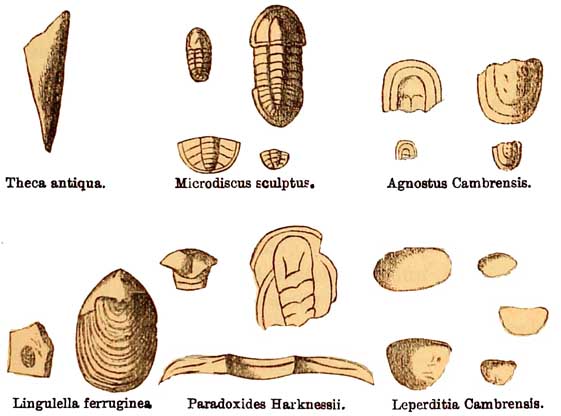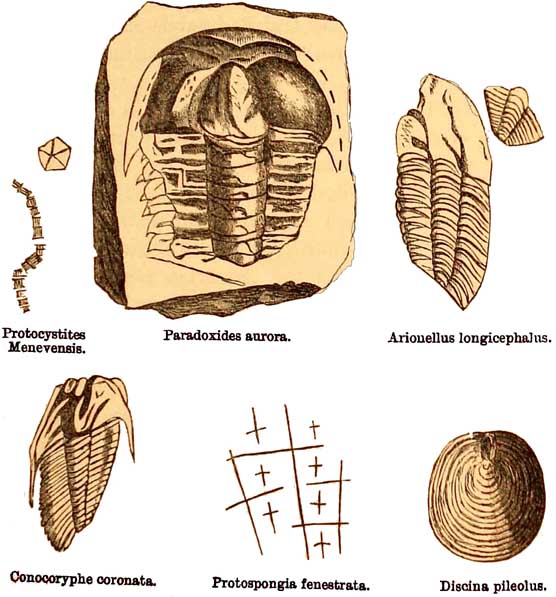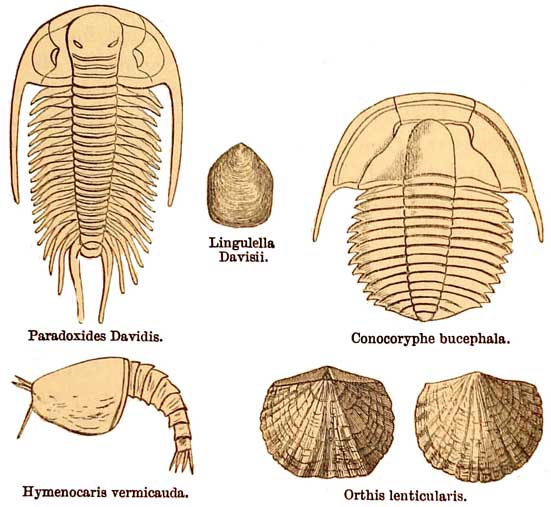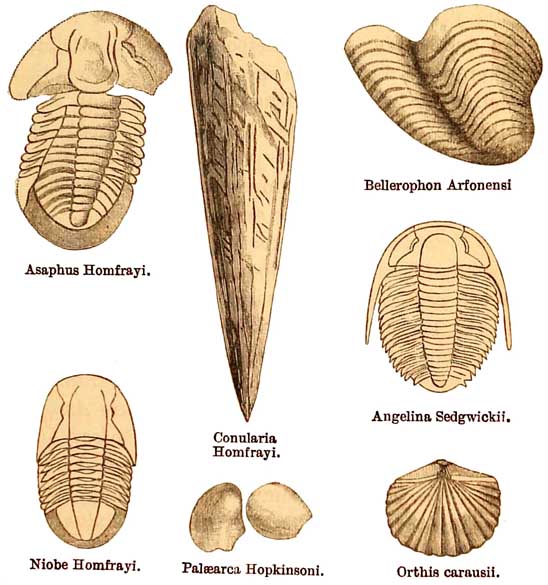CHAPTER V.
LAURENTIAN, CAMBRIAN, AND LOWER SILURIAN ROCKS.
THE LAURENTIAN ROCKS are the oldest formations at present known in the world. They are
metamorphic
and mostly gneissic in character, and were for long classed as granitic and igneous rocks till
their true nature was shown by the late Sir William Logan. They occupy vast tracts of country
in Labrador and Canada, and are well seen on the north of the river Ottawa. They consist of two
divisions, Lower and Upper Laurentian, the upper, according to Logan, lying quite
unconformably on the lower strata. The gneiss of the lower division is chiefly orthoclase gneiss
of great thickness, and it is interstratified with several thick bands of crystalline limestone,
sometimes serpentinous, in one of which a remarkable foraminifer called Eozoon Canadense was
found. This is the oldest known fossil. The upper Laurentian rocks, which also contain beds of
limestone, are to a great extent formed of Labrador felspar, and in these no fossils are known.
In the Outer Hebrides and on the west coast of the Highlands between Cape Wrath and Tiree,
Laurentian rocks occur of highly metamorphic gneiss, interpenetrated
[56 Laurentian Rocks.]
by numerous veins of granite. These strata much more closely resemble the Lower than
the Upper Laurentian rocks of Canada, and though, at so great a distance from America, it is
impossible to prove that they are equivalent formations, the presumption that they are of
Laurentian age is very strong, and not the less so that strata, having all the characters of
Cambrian rocks, lie quite unconformably upon them, fig. 54, p. 285. The district was first
described by Sir Roderick Murchison. I can answer for the accuracy of his descriptions, having
inspected the ground with him, and personally mapped a portion of the country at and about
Durness. I know of no other part of the British Islands in which Laurentian strata certainly
occur.1 No fossils have yet been observed in these British rocks.
The CAMBRIAN and SILURIAN ROCKS of the British series come next in succession. If these
strata were to be classified for the first time in England, with my present knowledge, I would
divide them into three, as the most convenient method. The first series would include the purple
and green grits and slates of the Longmynd and Wales, and range upward as high as the top of the
Tremadoc slates; the second would range from the base of the Arenig slates to the top of the Bala
or Caradoc beds, and the third from the base of the Upper Llandovery beds to the top of the
Ludlow rocks. In Wales and its neighbourhood, where the most typical series is found, each of
these great boundary lines is marked by unconformity, and analogous unconformities are more
or less found elsewhere in the British Islands.
1 After their discovery by Murchison, the Laurentian rocks and other details in the Highlands
were mapped by Professor Geikie, F.R.S. See his Geological Map of Scotland, 1876.
[Cambrian Rocks. 57]
It is probable, however, that only a few persons would as yet agree with me in this
classification, and indeed, since the first publication, by Mr. Murchison, of 'The Silurian
System,' dedicated to Professor Sedgwick in 1839, there has been, after a temporary lull, but
little unanimity among British geologists on a subject about which European and American
geologists care but little, and which is to a great extent a matter of local opinion.
In 1841 and 1842 Sir Henry de la Beche and those who worked with him, adopted the term
Cambrian for all the purple grits and slates of St. David's and the Longmynd, then supposed to be
unfossiliferous; while the name Silurian, nearly in the same sense as used by Murchison, was
employed for all the strata between the uppermost beds of these rocks and the top of the Ludlow
series. When the Government Geological Survey reached North Wales this classification
continued for a time unchallenged. Professor Sedgwick had previously called the equivalents of
part of these strata in the north of England the CUMBRIAN series, and at that time he called the
blue and grey slaty series of Wales the CAMBRIAN series, on the assumption, then unquestioned,
that they were all older than the recognised Llandeilo flags of Murchison. But in the progress of
investigation by Sedgwick and many others, it appeared that his original Cambrian, and
Murchison's original Lower Silurian strata, were in great part equivalent, and the great
Professor of Cambridge naturally reclaimed all that part of his kingdom, the boundaries of
which had, for all Wales, not been clearly defined when he first tried to subdue it. He therefore,
maintained, that the true Cambrian series included all the strata from the base of the purple
slates and grits
[58 Cambrian]
to the top of the Bala beds or Caradoc sandstone of Murchison.
By way of healing differences and striking a just middle boundary, Professor Phillips and Sir
Charles Lyell proposed that the term Cambrian should be used as including all the strata from
the known base of the Longmynd, St. David's, and North Wales purple grits and slates, through
the Lingula flags up to the top of the Tremadoc slates, a proposition which satisfied neither of
the claimants.
This is not a book in which
to enter into the details of a controversy which has comparatively little
interest beyond the confines of the British Islands, and will by-and-by be
forgotten along with other minor debates, that in their day were of equal
or more importance; but I have thought it worth while to sketch out the questions
involved, that in the conflict of lecturers and writers of memoirs and manuals,
ordinary readers may know something of the origin of the varieties of opinion
implied in the different nomenclatures. In the meanwhile I shall use the
old-fashioned nomenclature adopted by the Geological Survey, as most convenient
for me, seeing that if any one in reading this book should find it needful
to look at the maps and sections of that Survey, and at most other maps as
well, he will find the word Cambrian restricted to those strata, that at
St. David's, and in Merionethshire lie below the base of the Menevian beds.
In this sense, then :
THE CAMBRIAN ROCKS of Wales consist of the purple grits and slates, that form the greater part
of the group of hills that lie east of Cardigan Bay between the estuaries of the Mawddach and
most of the country S.S.W. of Ffestiniog. In that region their stratigraphical relation to the
overlying Lower Silurian
[Rocks. 59]
rocks will be seen by referring to fig. 62, p. 322. They form there the lowest central strata of
a broad anti-clinal curve. They are also well seen in the Passes of Llanberis and Nant Ffrancon in
Carnarvonshire, where the celebrated slate quarries of Penrhyn and Llanberis lie in these
strata. The slates are purple, purplish-blue, and green; and associated with them are beds of
greenish and grey grits and conglomerates. It is important to observe that at Llanberis the
latter contain numerous water-worn pebbles of felspathic traps, jasper, greenstone, black and
purple slate, &c., so that these, forming part of the oldest rocks of Wales, have been partly
derived from pre-existing rocky lands, similar to those that now form the neighbouring Silurian
country, but no visible trace remains of this more ancient physical geography, except the
pebbles in the conglomerate. In Anglesea the equivalent rocks are metamorphic chlorite and
mica-schist and gneiss.
Cambrian strata also occur in the hills of the Longmynd of Shropshire, where the strata stand
nearly on end. They consist of green, grey, and purple slaty rocks, grits, and conglomerates. The
only traces of fossils yet discovered in these consist of worm-burrows, and a trilobite,
Palæopyge Ramsayi.
FIG. 13.
Section across the Longmynd and Shelve country.

1. Cambrian grits and slates. 2. Lingula flags of the Stiper stones. 3. Tremadoc beds. 4. Llandeilo
and Caradoc rocks with igneous interstratifications. 5. Upper Llandovery and Wenlock rocks.
At St. David's, in North Pembrokeshire, in equivalent strata, Mr. Hicks found the following
fossils in
[60 Cambrian]
purple shales among the lowest beds of the series :—A small bivalve crustacean Leperditia
Solvensis and L. Cambrensis, two small Brachiopods, Lingulella ferruginea and L. primœva. In
a higher part of the series, consisting chiefly of yellowish sandstones and gray shales, he also
found two sponges (Protospongia) and various trilobites, Microdiscus sculptus, Conocoryphe
Lyellii and C. Solvensis, Paradoxides Harknessii, Plutonia Sedgwickii, Agnostus Cambrensis, and a Pteropod Theca antiqua. These rocks had previously been considered
FIG. 14.

Group of Cambrian Fossils.
unfossiliferous, and the discovery is important as showing that in sediments so old there
existed a considerable development of life of the same general type as that found in overlying
Silurian strata.
In Sutherlandshire, as already stated, red Cambrian conglomerates lie on the Laurentian strata
unconformabaly
[Rocks. 61]
ably, and fossils discovered in the north of Scotland by Mr. Peach prove that Lower Silurian
rocks (somewhat metamorphic) rest unconformably on both.
Till within the last few years it was customary to consider that all formations vhich had not
yielded fossilised fresh-water shells were of marine origin. Mr. Godwin-Austen first broke
through this fallacy, and often insisted that the Old Red Sandstone, as distinct from the Devonian
rocks, was deposited in fresh-water lakes.
In 1871, I published two memoirs in the Journal of the Geological Society, in which I attempted
to prove that in a broad sense, the red formations of Britain were deposited in lakes, salt or
fresh, or in inland areas in which salt and fresh water alternated. In one of these,1 I ventured to
state 'that the absence of marine mollusca in the Cambrian rocks' of North Wales and the
Longmynd, as yet observed, may be due to the same cause that produced their absence in the Old
Red Sandstone (see p. 106), and that 'the presence of sun-cracks and rain-pittings in the
Longmynd beds favours this suggestion.' The occurrence of marine fossils, chiefly in the grey
slates and 'olive-green grits and shales' of St. David's, as described by Mr. Hicks, 'may,' I state,
'possibly mark occasional influxes of the sea into inland waters, due to oscillations of level,'
producing the same kind of alternations of marine and fresh-water strata that occur in the
Carboniferous series, and in the Miocene beds of Switzerland and the Rhine.
It is but right to state, however, that, as regards the Cambrian rocks, mine is not the usual
opinion.
The LOWER SILURIAN rocks which conformably
1 On the Red Rocks of England of older date than the Trias. March 1871, 'Journal of the
Geological Society,' vol. xxviii.
[62 Menevian Beds.]
overlie the Cambrian strata, have been classed under various subdivisions, from the presence
in each of certain Trilobites and other fossils, sometimes peculiar to, and sometimes more or
less prevalent in, each subformation. To the oldest of these the name Menevian
FIG. 15.

Group of Menevian Fossils.
beds has been given, so called from Menapia, the old Roman name of St. David's. They are of
inconsiderable thickness, and are found both in that district
and in North Wales, circling round the Cambrian rocks of Merionethshire from Barmouth to
Harlech, and in
[Lingula Flags. 63]
both areas there is a lithological passage and conformity between the Cambrian and Menevian
strata, fig. 62, p. 322.
Four species of sponges are at present known in the Menevian beds of St. David's, named by Mr.
Hicks. They are all of his genus Protospongia, and one of them, P. fenestrata, is found in the
underlying Cambrian strata, also one Cystidean, Protocystites Menevensis, a few Annelid
tracks, and more than thirty species of Trilobites of the genera Agnostus, Arionellus, Anopolenus, Conocoryphe, Erinnys, Holocephalina, Paradoxides, and Carrausia. Of these, seven
species belong to the genus Agnostus, one of which, A. Cambrensis, is also found in the
Cambrian rocks, as its name implies. There are seven species of Conocoryphe, three of which
are also Cambrian species, viz. C. applanata, C. Bufo, and C. humerosa. Paradoxides aurora is
also common to both formations, and a few Brachiopoda, such as Discina pileolus, Lingulella
ferruginea and Obolella sagittalis. Of Pteropods the genus Theca is common, but, as far as I
know, no Lammellibranch molluscs or Gasteropoda are found in these strata.
The Lingula flags rest conformably on, and in fact pass by lithological gradations into the
Menevian beds (fig. 62, p. 322). They are best developed in Merionethshire, Carnarvonshire,
and at St. David's, and consist of black and gray slaty rocks with beds of grit.
In these a marked and distinctive suite of fossils occurs, the chief of which are Lingulella Davisii, and many genera of Crustacea—Conocoryphe bucephala and two others, Agnostus (4),
Paradoxides (2), Holocephalina (1), Anapolenus (2), Erinnys, and Conocephalus—all
Trilobites; also a phyllopod crustacean,
[64 Lingula Flags.]
Hymenocaris vermicauda, and the bivalve crustacean Leperditia bupestris. Various annelids are
found, Cruziana, &c., and in the higher part of the strata Polyzoa, of the genus Fenestella,
together with a few
FIG. 16.
 Group of Lingula Flag Fossils.
Group of Lingula Flag Fossils.
brachiopoda of the genus Orthis, O. lenticularis and others, Obolella sagittalis and maculata, and
Discina labiosa, three species of Theca (pteropods), &c.
Of the fossils of this formation Protospongia fenestrata is common in the strata from the Cambrian to the Lower Lingula flags, Agnostus Davidis
and A. scutalis, Anopolenus Henrici, A. Salteri are also found in the Menevian beds, together
with Conocoryphe applanata, and C. humerosa, both of which begin in
[Tremadoc Slates. 65]
the Cambrian strata, while C. variolaris is common
to the Lingula and Menevian strata. Paradoxides
Harknessii, P. Hicksii, and P. aurora are common to all three formations, and P. Davidis to the
two higher divisions. The same kind of passage of species upward from the Cambrian slates and
grits to the Lingula flags, may be observed in some of the few genera and species of Brachiopoda,
Lamellibranchiata, and Pteropoda, and I have specially insisted on this, in connection with the
fact, that at the junction of the so-called three formations, there is no marked line of division,
but a lithological gradation from the lower to the higher strata, accompanied by the passage of
species from lower to higher geological horizons.
The Tremadoc slates succeed the Lingula flags, and may be considered as an upper member of
that series, while the red and grey Cambrian rocks form a lower member. There is no clear
lithological boundary-line between them, and the whole lie conformably. Fourteen genera of
Trilobites are known in Wales from these strata, the most characteristic of which are Asaphus
Homphrayi, &c., Angelina Sedgwicki, Psilocephalus inflatus, &c, and Niobe Homphrayi.
Several of the genera of Trilobites are common to the Lingula flags and the Cambrian beds below.
Of these, Agnostus princeps is found in the Menevian beds, and Conocoryphe depressa, C.
invita, and Olenus alatus in the Lingula flags. Orthis Carausii is a characteristic brachiopod,
and Lingulella Davisii and L. lepis are common to these strata and to the Lingula flags, together
with Obolella plicata and O. Salteri, while O. sagittalis ranges from the Cambrian up to the
Tremadoc slates. In Ramsey Island near St. David's many Lamllibranchiate molluscs have
been found by Mr. Hicks, of
[66 Tremadoc Slates.]
the genera Palcœarca, Glyptarca, Davidia, Modiolopsis,
and others also Theca operculata and other Pteropoda,
and several species of Bellerophon occur (B. Arfonensis,
&c), together with Cephalopoda, viz., Orthoceras sericeum,
FIG. 17.

Group of Tremadoc Slate Fossils.
and Cyrtoceras prœcox; also Encrinites, and a starfish, Palasterina Ramseyensis.
Altogether, as
now known, the life of the time was richer than that of the Cambrian and Lingula flag strata, but
all of these faunas are probably very imperfect and fragmentary in the Biitish area.
[Physical Geography. 67]
Leaving these details of stratification, I will now endeavour to catch a glimpse of the physical
geography of our area during the time that the Cambrian, Lingula, and Tremadoc rocks were
being deposited. I have already stated that the purple strata of the Cambrian series seem to me to
have been deposited in inland fresh waters, subject to influxes of the sea, probably owing to
occasional subsidence of the land; in the same manner, for example, that in Tertiary times the
Miocene strata of Switzerlarìd and the Rhine were deposited in great fresh-water lakes, in
areas that underwent local temporary submergence. The thick strata of sandstones in the
Cambrian rocks of Merionethshire, indicate the neighbourhood of land, and in Caernarvonshire
the numerous beds of sandstone and coarse conglomerate interstratified with mud deposits—now
slates, point not only to the proximity of land, but even give a clear idea of the kinds of rock of
which that land was made. 'In the 8,000 feet of these rocks in Merionethshire there is very
little slate, and even the 700 or 1,000 feet of interstratified slaty beds in Caernarvonshire are
quite subordinate to the grits and conglomerates. …'
'The structure of this land may be partly inferred from the nature of the
pebbles in the conglomerate, which are water-worn, and consist of purple
and black slates, quartz-rock, felspathic traps, quartz-porphyries, and jaspers.'
The country from which these pebbles were derived must, indeed, have physically resembled
North Wales of the present day, 'but except these pebbles no trace of that land remains in or
near North Wales.'1 Fragments of this old continent, however, probably still exist in the
Laurentian rocks of the Outer
1 The Geology of North, Wales,' p. 160. A. C. Ramsay.
[68 Physical Geography.]
Hebrides, on the coast of the West Highlands, where exceedingly red Cambrian sandstones and
conglomerates lie quite unconformably on the Laurentian strata.
While the Menevian and Lingula
beds were being deposited I think it more than probable that the pre-Cambrian
continent still existed, for in the gritty strata that form a large part
of the Lingula flags, and in the frequent presence of current marks (often
called ripplemarks), there are many signs that these strata were deposited
in shallow water, and thus it would happen, that during the time when these
and the Tremadoc beds were being formed, the whole area was undergoing a
process of slow sinking, into which sediments were being constantly carried,
just in proportion as the gradual depression went on, so that, in the long
run, what with the effects of sub-aerial degradation, and what with the
results of progressing submersion, the old pre-Carabrian land of this neighbourhood
finally was buried and disappeared.





